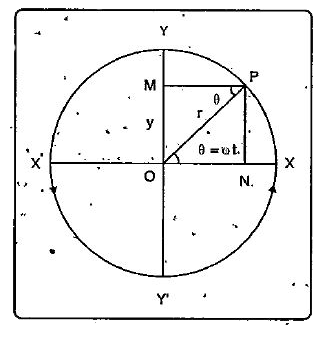Define simple harmonic motion. Show that the motion of (point) projection of a particle performing uniform circular motion, on any diameter is simple harmonic.
Text Solution
Simple harmonic motion : A body is said to be in S.H.M, if its acceleration is directly proportional to its displacement, acts opposite in direction towards a fixed point. Relation between uniform circular motion and S.H.M.: Let a particle .P. is rotating in a circular path of radius .r. with a uniform angular velocity .ω.. Let .O. is the centre of the circle. After a small time .t. it goes to a new position say .P.. Draw normals from .P. on to the X - axis and on to the Y - axis. Let ON and OM are the projections on X and Y axis respectively. As the particle is in motion it will subtend an angle θ=ωt at the centre.

From triangle OPN the projection on X-axis ON = OPcosθ
But OP = r and θ=ωt.
∴ Displacement of particle P on X - axis at any time t is X=rcosωt........ (1)
From triangle OPM the projection on Y - axis is ON = Y = OP sinθ
But OP = r and θ=ωt
∴ Displacement of particle P on Y-axis is
Y=rsinωt ....... (2)
As the particle rotates in a circular path the foot of the perpendiculars OM and ON will oscillate with in the limits X to X1 and Y to Y1. At any point the displacement of particle P is given by OP2=OM2+ON2
Since OM = X = rcosωt and ON = Y = rsinωt.
So a uniform circular motion can be treated as a combination of two mutually perpendicular simple harmonic motions.
|
Topper's Solved these Questions
Similar Questions
Knowledge Check
In a simple harmonic motion
Athe potential energy is always equal to the kinetic energyBthe potential energy of is never equal to the kinetic energyCthe average potential energy in any time interval is equal to the average kinetic energy in that time intervalDthe average potential energy is one time period is equal to the averge energy is this periodIn a simple harmonic motion
Athe maximum potential energy equals the maximum kinetic energyBthe minimum potential energy equals the minimum kinetic energyCthe minimum potential energy equals the maximum kinetic energyDthe maximum potential energy equals the minimum kinetic energy.In simple harmonic motion,the particle is
Aalways accelerationBalways retardedCalternately acceleration and retardedDneither acceleration nor retarded
In simple harmonic motion,the particle is
View SolutionSimple harmonic motion is the projection of uniform circular motion on
View SolutionSimple harmonic motion is the projection of uniform circular motion on
View SolutionAssertion :Simple harmonic motion is not a uniform motion.
Reason : It is the projection of uniform circular motion.
View SolutionAssertion: Simple harmonic motion is the projection of uniform circular motion on the diameter of the circle in which the latter motion occurs.
Reason: Simple harmonic motion is a uniform motion.
View Solution
